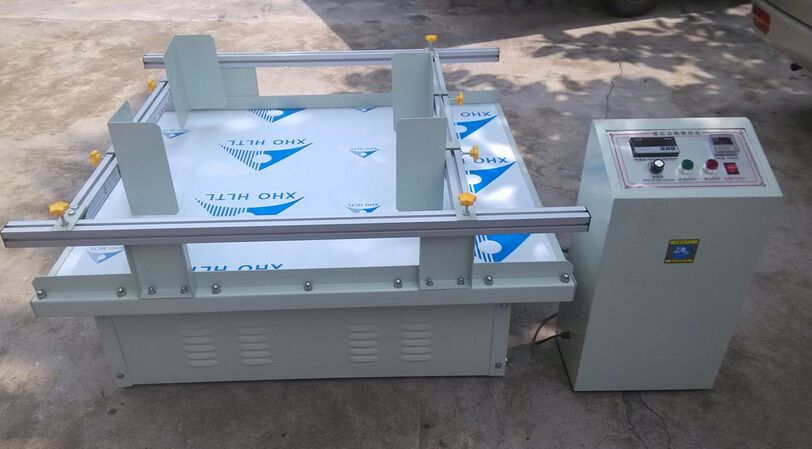ASTM D4728-12 Vibration Test with Environmental Conditioning
The ASTM D4728-12 standard provides a comprehensive method for simulating the effects of vibration and environmental conditions on packaging materials. This test is particularly critical in ensuring that packaging can withstand the rigors of transportation, storage, and handling without compromising product integrity or safety.
When it comes to testing packaging under these conditions, ASTM D4728-12 specifies a range of frequency bands (typically from 5 Hz to 300 Hz) where environmental factors such as temperature, humidity, and pressure play crucial roles. The test aims to replicate real-world scenarios that the packaging might encounter during shipment or in transit.
The process involves placing specimens within controlled vibration chambers designed to generate specific frequency bands and amplitudes of vibration. These vibrations are often combined with other environmental conditions like thermal cycling, humidity variations, and atmospheric pressure changes. The specimen's response is monitored throughout the test period to assess its performance under these stressors.
One key aspect of this testing method is understanding the impact of different materials used in packaging design. For instance, a rigid container may behave differently from a flexible one when subjected to similar vibration frequencies and intensities. Therefore, it's essential to tailor the test parameters according to the nature of the packaging being evaluated.
Another important consideration is the environmental conditions that should be present during testing. Temperature can vary widely depending on whether the product is destined for tropical or arctic regions, while humidity levels could also differ based on the time of year and geographical location. Pressure variations might occur if the package is to be transported in aircraft cargo holds.
The ASTM D4728-12 protocol emphasizes the importance of precise control over these variables since even minor deviations can affect test results significantly. By adhering strictly to specified limits, laboratories ensure accurate representations of real-world conditions experienced by packaging materials during transit or storage.
A successful outcome from an ASTM D4728-12 vibration test indicates that the tested packaging has demonstrated sufficient resilience against mechanical shocks and environmental stresses without compromising its structural integrity. This assurance is vital for manufacturers looking to maintain high standards of quality control across various industries including pharmaceuticals, electronics, consumer goods, and food & beverage sectors.
For those involved in supply chain management or product development cycles, understanding the nuances behind ASTM D4728-12 can help optimize packaging designs early on. Proper planning allows companies to anticipate potential issues before they become costly problems later down the line.
In conclusion, mastering ASTM D4728-12 vibration testing ensures robust and reliable packaging solutions which not only protect valuable cargo during transport but also enhance brand reputation by delivering consistent product quality regardless of environmental challenges faced along the way.
Why It Matters
The importance of ASTM D4728-12 vibration testing cannot be overstated, especially in today's globalized market where products are frequently shipped across continents. Proper packaging design ensures that goods arrive at their destination in pristine condition despite the harsh conditions they may face during transit.
- Reduces Costs: By preventing damage to packages and contents, this test helps minimize post-shipping returns and replacements, thereby saving money for businesses.
- Promotes Safety: Ensuring that packaging withstands specified levels of vibration minimizes risks associated with improperly secured cargo during transit.
- Enhances Reputation: Consistent adherence to best practices like ASTM D4728-12 reflects positively on a company's commitment to excellence and reliability.
- Meets Regulatory Requirements: Many international standards bodies recognize ASTM D4728-12 as the gold standard for such tests, making compliance easier when importing/exporting goods internationally.
In essence, implementing ASTM D4728-12 vibration testing is not just about meeting industry expectations; it's an investment in long-term success and sustainability. It enables companies to build trust with customers while simultaneously reducing operational costs through improved efficiency and reduced waste.
Industry Applications
- Packaging Design: Testing the durability of packaging materials under simulated vibration conditions helps designers refine their products before mass production.
- Manufacturing: Ensures that newly developed packaging meets quality standards set forth by ASTM D4728-12, thereby enhancing overall manufacturing processes.
- R&D: Provides valuable data for researchers working on innovative packaging solutions aimed at improving performance under adverse conditions.
- Supply Chain Management: Facilitates better planning and execution of shipping routes by ensuring packages can handle expected vibrations during transit.
These applications highlight how ASTM D4728-12 vibration testing plays a pivotal role in safeguarding products throughout their lifecycle, from production to delivery. This ensures that businesses operate efficiently while maintaining high standards of quality and safety.
International Acceptance and Recognition
The ASTM D4728-12 vibration test enjoys widespread recognition within the packaging industry globally due to its rigorous methodology. Many countries have adopted this standard as part of their national testing protocols, reflecting its universal applicability.
A significant advantage of using ASTM D4728-12 is that it aligns closely with international regulations and guidelines. This consistency across borders simplifies compliance processes for companies operating in multiple jurisdictions. Furthermore, adherence to these standards enhances cross-border trade by reducing misunderstandings or discrepancies related to product specifications.
International bodies such as ISO (International Organization for Standardization) have referenced ASTM D4728-12 in their own documents, further cementing its status within the industry. By aligning with internationally recognized standards like these, businesses demonstrate their commitment to maintaining high-quality packaging solutions that meet global expectations.
The widespread acceptance of ASTM D4728-12 also fosters collaboration among stakeholders worldwide. It encourages knowledge sharing and best practice exchange, ultimately driving innovation in the field of packaging technology.





